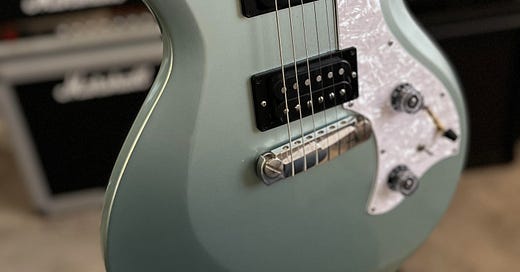Over the years, my guitar journey has led me to a deep appreciation for Paul Reed Smith instruments. I'm fortunate to own several, and each "Made in Maryland" guitar has offered a unique and rewarding experience. While I still lament the sale of a 2003 Standard 22 – a decision I've long since kicked myself over – today, I want to shine a spotlight on a guitar truly worth seeking out: the original run of PRS Mira.
Produced from 2007 until its integration into the S2 line in 2013, the core-line Mira is a distinct beast from its successor in the S2 line. Though I haven't played an S2 Mira, my experience with two identical original Miras has convinced me that this model deserves a permanent place in PRS's core lineup.
So, what makes this unassuming, vintage-inspired all-mahogany guitar so special? While the Mira line saw variations over its lifespan – including a P90 variant, a flamed maple top model, and one with a different scale length – today, we're diving into the fundamental specifications of the original run. In my mind, Joe Knaggs and Paul Smith masterfully crafted what I consider a perfect double-cut Les Paul Special, but with humbuckers.
Original PRS Mira (2008-2013) Key Specifications:
Body and Neck: Solid mahogany construction, offering a lightweight yet resonant feel, comparable in thickness to a Gibson SG.
Fretboard: Rosewood, featuring a comfortable radius that's neither too flat nor excessively curved, ensuring excellent playability without fretting out.
Neck Profile: Substantial yet comfortable; it's not a "baseball bat" but certainly offers more heft than ultra-thin profiles like the Ibanez Wizard III. This is the most appealing aspect of the guitar's feel. I believe this was known as the Pattern Thin neck at the time.
Bridge: Compensated wraparound bridge. Surprisingly, despite my usual intonation concerns with such designs, the Mira's bridge performs flawlessly. This is the same bridge found on the PRS SC250, a guitar I consider the Mira's close cousin.
Pickups: Uncovered PRS SC250 humbuckers. These medium-output pickups, coupled with a coil-splitting switch (a feature not typically found on the SC250 itself), deliver a bright, articulate tone with incredible dynamic range via the volume control. They perfectly complement the guitar's inherent characteristics. I've even tried, unsuccessfully, to persuade PRS to wind me a set with their new bobbin layout for my CE-24, though I understand the 57/08 pickups offer a similar sonic vibe.
Controls: Simple and intuitive, mirroring the minimalist approach of classic solid-body guitars. Just a volume, tone, 3-way switch, and a coil tap.
The Mira, for me, is a refreshing palate cleanser in today's guitar landscape. While brands constantly strive to "push boundaries" – thankfully, the cold war of headless guitars seems to be waning, only to be replaced by a deluge of Stratocaster derivatives (a topic for another day, despite my love for Strats) – the Mira remains a testament to timeless design.
Though it enjoyed a surge in popularity from 2008-2010, the Mira has since become a cherished secret within the guitar community. Its simplicity belies its versatility, allowing it to seamlessly transition from jazz to heavy metal. How can this unassuming blue guitar hold its own playing heavy riffs? It's all in the alchemy of its design and components.
Recession-era Miras (roughly 2008-2010) are currently appearing on the used market in the $900-$1700 range, offering exceptional value. Securing a model closer to 2008 is particularly advantageous, largely due to the spectacular quality of wood PRS had access to during that period. While their current wood stock is undoubtedly excellent, there's a certain magic to those recession-era instruments. This could be attributed to the natural aging of the wood or perhaps the simplified company structure at the time. With only the overseas SE line in production, and the original Maryland factory. Maryland-made guitars like the Mira and DC3 were built alongside Custom 24s and Modern Eagles on the same production line. This smaller scale often brings inherent benefits, and in my experience, the original Miras boast few, if any, drawbacks.
My own 2008 Mira is a guitar I have no intention of modifying; I adore it precisely as it is. It takes me back to 2011, when a new Mira, in the same shade of blue, became my first truly nice guitar. I remember having pictures of the Mira plastered on my walls, a dream guitar from my first job in 2008, working for meager wages in restaurants or seasonal over-summer jobs, yet brimming with excitement for the opportunities ahead. While I've thankfully moved on to a different career, that same jolt of excitement, reminiscent of first owning one and working my first job, still courses through me every time I pick up my Mira. And this time, I won't be selling it to fund a lesser, seven-stringed instrument!




